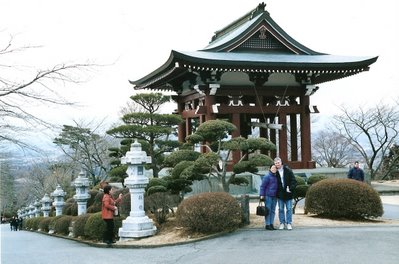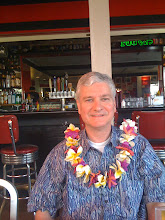Tokyo, Japan - Part II
On Monday, I went to work at the Shibuya-ku district and Catherine went with me. My client in Japan had faxed me hand written directions and a map to the office. However, in Tokyo there are no street signs and the buildings are numbered in a random fashion. So you start with the Ward or district a large section of the City. Tokyo is comprised of 23 Wards. In my case the Ward I was looking for was Shibuya-Ku. This gave me a general idea of where the address was. The District is further subdivided into subsections called Chome. The first number of the address is the Chome, or subsection of the District within the Ward.
Now this is where it gets a bit complicated. The problem is that the buildings are not numbered sequentially. Actually, they're numbered in the order in which they were constructed. Given the amount of destruction and aggressive development that Tokyo has witnessed over the past 75 years, it's extremely unlikely that any adjoining buildings in the City were built consecutively. This addressing scheme means that even if you know the system like a native, there is still no way to find addresses on the first try. Usually you'll spend a lot of time wandering around an area, looking at maps and wondering which direction is north. It's all a process of trial and error, and if it's any consolation, the Japanese don't seem to understand the system either. Ask strangers on the street for help finding an address and there's a good chance that no two people will agree. Well, anyway I spend some time looking for the building where I was working and when I finally found it, I said goodbye to Catherine. She went out for the day and I went to work.
A CPA from our Tokyo office worked with me because she spoke English and Japanese and could translate for me. We all exchanged business cards the first day when we met, which in Japan is quite a process of formally presenting your business cards with both hands and bowing to one another. So I would tell the Japanese CPA the questions I wanted to ask our clients. She would translate the question for them, listen to their answers, and then translate back to me. Often I would ask a question, she would have an extended conversation with the clients and then provide a very brief answer back to me. If you have ever seen the movie "Lost in Translation", the experience was very much like Bill Murray's experience with the director of the commercial he was making.
At noon the client took me to lunch at a Japanese restaurant and by that night I was quite exhausted and ready to relax a little. I met back up with Catherine and we found an Italian restaurant with really good food. One of the cooks was Italian and spoke English so we were able to order using him as our translator.
That day for lunch I grabbed a bento lunch box. Bento box lunches are very popular among both Japanese kids and adults. People take them to work, to school, on picnics, and so on. Half of a typical bento consists of rice, and the other half consists of several side dishes made with such ingredients as vegetables, meat, fish, and eggs. Well I easily purchased the lunch in a mall in the building where I worked. I left the mall thinking I would find a place to sit outside and eat. Well there was no place to sit. I didn’t dare sit on the building steps for fear of being run over. In front of the Shibuya-Ku train station across the street from where I worked there was a short wall that was specifically built so you could lean against it. So I leaned and ate my lunch.
In front of me as I ate my lunch there was a bronze statute of a dog. I later found out that the dog's name was Hachiko. He is Japan's version of the faithful dog. Hachiko's master, a professor at Tokyo University, would take the dog with him every morning as far as Shibuya-ku Station on his way to work, and Hachiko would go back to the station every evening to greet him on his return. One day in 1925 the professor failed to appear, he had died of a stroke. Every evening for the next seven years, Hachiko would go to Shibuya-ku and wait there hopefully until the last train had pulled out of the station. Then the dog also died and his story made the newspapers. A bronze statute of Hachiko was installed in front of the station, funded by thousands of small donations from readers all over the country.
Use the search box at the bottom of this page to find previous postings on London, Amsterdam, Japan, Germany, Austria, Yellowstone, New York, Boston, Switzerland, Alps, Plymouth Mass., Washington DC, San Francisco, Manila, San Diego or Quebec.
Labels: Bento Box, Bill Murray, Dog, Hachiko, Japan, Japanese Imperial Palace, Photographs, Photos, Pictures, Shibuya-ku, Shinto Shrine, Tokyo, Translation






3 Comments:
Very interesting. I'm headed for Japan next February/ March. I'll be staying in Chiba, a suburb. by the way... where is part I?
I found this through the blog http://www.roadgladiator.com/.
As a Japanese living in the US who frequently travels to Japan on business, it's always interesting to hear other westerner's experiences. Though I must admit...you are a brave person to try to eat lunch in Shibuya's Hachiko-mae...that place is usually a zoo...
I found your account of working with a translator amusing. As someone who also does double duty as a translator when I go on a trip with someone else from the office, I TRY not to make them feel that way...
Oh...and by the way...in the very first picture, I take it you were at the temple in Asakusa. That's a Buddhist temple and not a Shinto shrine. One easy way to distinguish one from the other is, in front of the offering box, if there is a bell or you see people clapping their hands before praying, it's Shinto. Otherwise it's Buddhist. Hard to tell sometime I know...
It sounds like you had an interesting and a good time too. I hope you will be able to come back to Japan and explore more of our culture!
I have never been to Tokyo. Your account of specific events (i.e. having to lean on a wall to eat or having to walk with the mass of people to cross) bring a certain nostalgia for travel. New cultures are spectacular. Those memories of times when we are uncertain on how to behave in public is one we appreciate most once it has passed.
Post a Comment
Subscribe to Post Comments [Atom]
<< Home